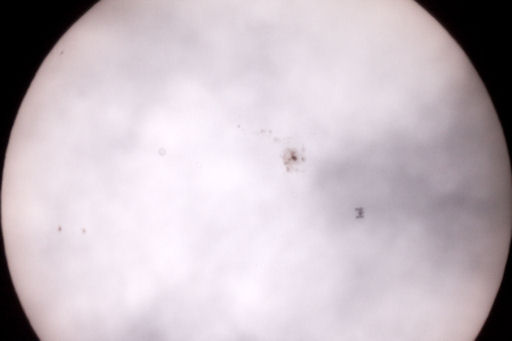INCOMING CME (UPDATED): On May 11th at 23:54 UT, a coronal mass ejection raced away from the sun faster than 1000 km/s. The fast-moving cloud will deliver a glancing blow to Earth's magnetic field on May 14th around 14:30 UT, according to a revised forecast track prepared by analysts at the Goddard Space Weather Lab. Mars is also in the line of fire. Magnetic storm alerts: text, phone.
SUNSET OVER PARIS: Huge sunspot AR1476 poses a threat for strong solar flares, but for the past two days the so-called "active region" has been mostly quiet. What the sunspot lacks in drama, however, it more than makes up for in beauty. Consider this photo of last night's sunset over Paris:
"Shooting from the Bridge of Concorde, I captured the sunspot setting behind the Eiffel Tower," says photographer VegaStar Carpentier. The light of the low-hanging sun was perfectly dimmed for a 1/1000s exposure @ ISO 400. "I used a Canon EOS 1000D."
The quiet is probably temporary. NOAA forecasters estimate a 75% chance of M-class flares and a 20% chance of X-flares during the next 24 hours.
more images: from the Charlie Bates Solar Astronomy Project of Atlanta, GA; from Luis Argerich of Buenos Aires, Argentina; from Eduard Garcia Ribera of Ager, Lleida, Catalonia; from Andy Devey of Sorbas, Spain; from Vasilis Wooseas of Greece, Amvrakikos Wetlands National Park; from Giuseppe Petricca of Pisa, Tuscany, Italy; from Catalin Fus of Krakow, Poland
SPACESHIP IN THE SUN: The sunspot number briefly jumped yesterday when a winged silhouette crossed the solar disk over Hampshire, UK. James West was watching the sun with a solar-filtered telescope when the transit occured:
"The International Space Station passed right by giant sunspot AR1476," says West. "The sky was partly cloudy but I caught the transit anyway."
The sunspot-spaceship encounter was no surprise to West. It had been predicted beforehand by CalSky.org. Readers who wish to take this kind of photo should check CalSky for transit predictions and read West's observing tips. A safe solar observing system might also come in handy: Space Weather Store.

![]()
Solar wind
speed: 572.6 km/sec
density: 0.2 protons/cm3
explanation | more data
Updated: Today at 1656 UT
![]()
X-ray Solar Flares
6-hr max: C2 1325 UT May12
24-hr: C3 0008 UT May12
explanation | more data
Updated: Today at: 1700 UT
![]()
![]()
![]()
Daily Sun: 12 May 12
![]()
![]()
Sunspot 1476 poses a continued threat for X-class solar flares. Credit: SDO/HMI
![]()
![]()
![]()
Sunspot number: 102
What is the sunspot number?
Updated 11 May 2012
Spotless Days
Current Stretch: 0 days
2012 total: 0 days (0%)
2011 total: 2 days (<1%)
2010 total: 51 days (14%)
2009 total: 260 days (71%)
Since 2004: 821 days
Typical Solar Min: 486 days
Updated 11 May 2012
The Radio Sun
10.7 cm flux: 136 sfu
explanation | more data
Updated 11 May 2012
![]()
![]()
![]()
Current Auroral Oval:
![]()
Switch to: Europe, USA, New Zealand, Antarctica
Credit: NOAA/POES
![]()
![]()
![]()
Planetary K-index
Now: Kp= 3 quiet
24-hr max: Kp= 3 quiet
explanation | more data
![]()
Interplanetary Mag. Field
Btotal: 4.7 nT
Bz: 2.1 nT north
explanation | more data
Updated: Today at 1655 UT
![]()
![]()
![]()
Coronal Holes: 11 May 12
![]()
![]()
Earth is inside a solar wind stream flowing from this coronal hole. Credit: SDO/AIA.






